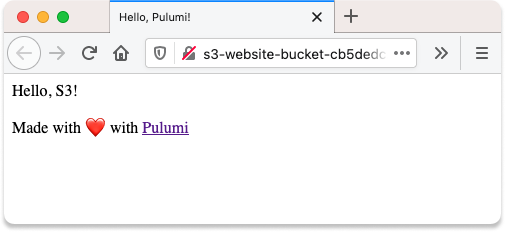A static website that uses S3's website support. For a detailed walkthrough of this example, see the tutorial Static Website on AWS S3.
Note: Some resources are not yet supported by the Native AWS provider, so we are using both the Native and Classic provider in this example. The resources will be updated to use native resources as they are available in AWS's Cloud Control API.
Note: some values in this example will be different from run to run. These values are indicated
with ***.
-
Create a new stack:
$ pulumi stack init dev
-
Set the AWS region:
Either using an environment variable
$ export AWS_REGION=us-west-2Or with the stack config
$ pulumi config set aws:region us-west-2 $ pulumi config set aws-native:region us-west-2
-
Restore NPM modules via
npm installoryarn install. -
Run
pulumi upto preview and deploy changes. After the preview is shown you will be prompted if you want to continue or not.$ pulumi up Previewing update (dev) ... Updating (dev) View Live: https://app.pulumi.com/***/aws-native-ts-s3-folder/dev/updates/1 Type Name Status + pulumi:pulumi:Stack aws-native-ts-s3-folder-dev created + ├─ aws-native:s3:Bucket s3-website-bucket created + ├─ aws:s3:BucketPolicy bucketPolicy created + ├─ aws:s3:BucketObject index.html created + └─ aws:s3:BucketObject favicon.png created Outputs: bucketName: "***" websiteUrl: "http://***.s3-website-us-west-2.amazonaws.com" Resources: + 5 created Duration: ***
-
To see the resources that were created, run
pulumi stack output:$ pulumi stack output Current stack outputs (2): OUTPUT VALUE bucketName *** websiteUrl http://***.s3-website-us-west-2.amazonaws.com
-
To see that the S3 objects exist, you can either use the AWS Console or the AWS CLI:
$ aws s3 ls $(pulumi stack output bucketName) 2021-09-30 15:27:58 13731 favicon.png 2021-09-30 15:27:58 198 index.html -
Open the site URL in a browser to see both the rendered HTML and the favicon:
$ pulumi stack output websiteUrl ***.s3-website-us-west-2.amazonaws.com -
To clean up resources, run
pulumi destroyand answer the confirmation question at the prompt.
